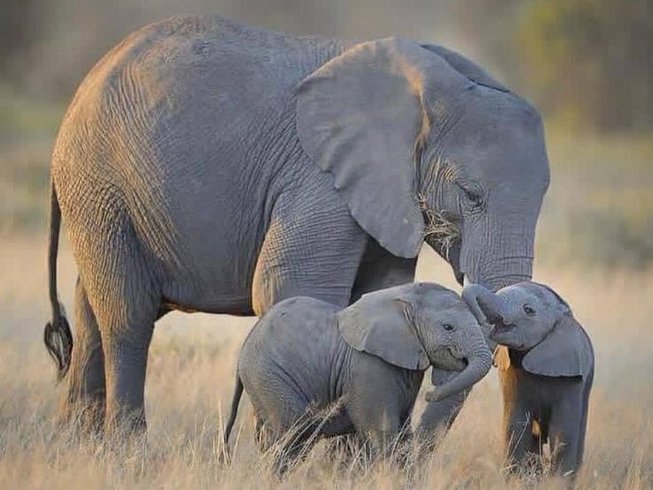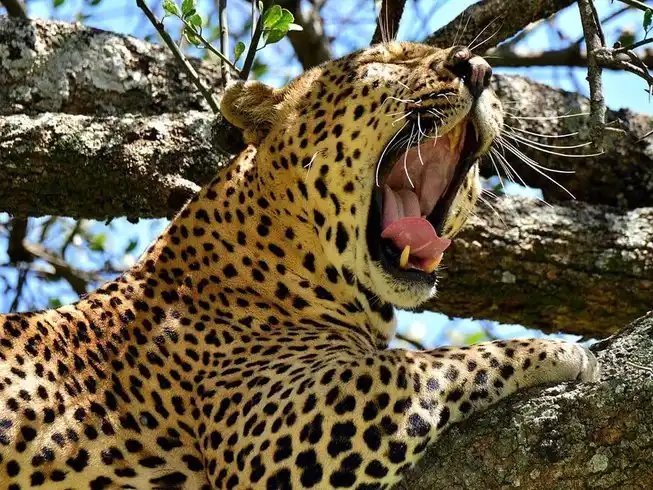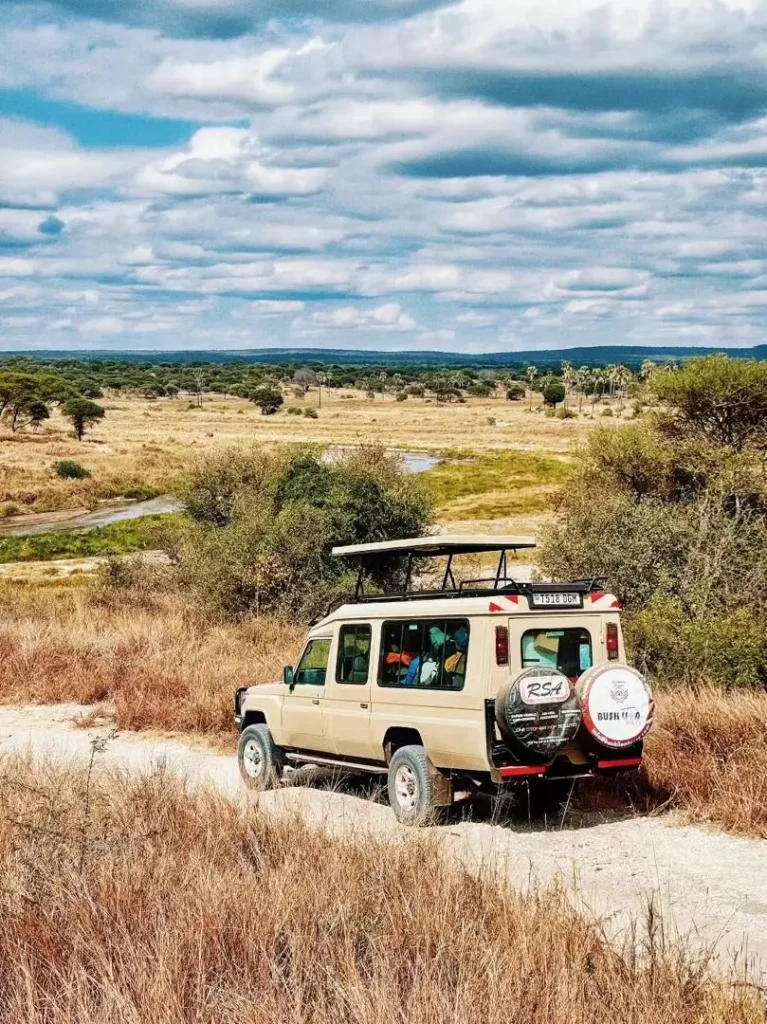Call +255 783 884 129
Serengeti National Park, located in northern Tanzania, is one of Africa’s most iconic wildlife destinations, covering around 14,763 square kilometers. It forms the heart of the larger Serengeti ecosystem, which stretches into Kenya’s Maasai Mara. The park is world-famous for hosting the Great Wildebeest Migration, one of the most spectacular wildlife events on Earth.
The Serengeti’s vast open plains, dotted with acacia trees and granite kopjes, create a perfect African safari setting. Its elevation ranges between 920 and 1,850 meters above sea level, offering diverse habitats including savannahs, woodlands, and riverine forests. This ecological variety supports an incredible abundance of wildlife, including the Big Five — lion, elephant, leopard, buffalo, and rhino — as well as cheetahs, giraffes, zebras, crocodiles, and more than 500 bird species.
The Seronera Valley in central Serengeti is rich with wildlife all year, while the southern plains serve as calving grounds early in the year. From May to October, the western corridor and northern Serengeti become migration hotspots, attracting predators and dramatic scenes of survival. Whether you come for the Great Migration or to enjoy its quieter corners, Serengeti promises an unforgettable safari filled with natural beauty and adventure.
Serengeti National Park is a sanctuary for over 3 million large mammals and 500+ bird species, making it one of the richest ecosystems on the planet. The park’s most famous event, the Great Migration, involves over 1.5 million wildebeest, 200,000 zebras, and 300,000 gazelles moving across the plains in search of greener pastures followed by lions, cheetahs, hyenas, and other predators.
Throughout the year, visitors can spot the Big Five and many other animals including hippos, giraffes, crocodiles, warthogs, jackals, servals, and bat-eared foxes. Bird enthusiasts will enjoy seeing kori bustards, ostriches, secretary birds, lilac-breasted rollers, and numerous raptors and waterbirds.
What makes the Serengeti unique is the raw drama of nature it offers from river crossings filled with tension to peaceful moments among massive herds. Whether during the calving season in the south or the river crossings in the north, Serengeti is a photographer’s paradise and a dream destination for all nature lovers.


Serengeti National Park offers countless unforgettable experiences for every type of traveler:
The Great Migration: Watch millions of wildebeest, zebras, and gazelles move across the plains and face dramatic river crossings at the Grumeti and Mara Rivers.
Game Drives: Explore the park by 4×4 with expert guides to spot lions, leopards, elephants, rhinos, buffalo, and more. Early morning and sunset drives offer perfect photo moments.
Hot Air Balloon Safari: Float above the plains at sunrise for a breathtaking bird’s-eye view of wildlife, ending with a champagne breakfast in the bush.
Walking Safaris: Get closer to nature with guided walks that focus on smaller animals, plants, and tracking wildlife on foot.
Private Camps & Mobile Safaris: Enjoy exclusive experiences in remote areas, ideal for travelers seeking privacy and adventure.
Every moment in the Serengeti from a lion’s roar at dawn to stargazing under the vast African sky tells a story of wilderness and wonder.

The name “Serengeti” comes from the Maasai word “Siringet”, meaning “the place where the land runs on forever.” This perfectly describes the park’s endless plains that stretch to the horizon. The Maasai people have lived around this ecosystem for centuries, herding livestock and coexisting with wildlife in harmony with nature.
When Serengeti was established as a national park in 1951, the name was kept to honor both the natural beauty of the land and its cultural connection to the Maasai. Today, the park stands as a symbol of African heritage, conservation, and cultural pride, preserving one of the most important wildlife ecosystems in the world.
EXCELLENTVerified 6 days machame route + 5 days safari Had the luck to climb Kilimanjaro and have a 5 days safari with Bush Lions. We ended up really happy and accomplished by these experiences! Thank you so much!Verified Highly, highly recommended Jackson @Bush Lion Tours Our journey with Bush Lion Tours Jackson was nothing short of extraordinary. From the very first moment we contacted him, everything was handled with the highest level of professionalism, warmth, and care.We climbed Mount Kilimanjaro with their amazing team, and thanks to their expert guides, flawless logistics, and constant encouragement, we not only reached the summit safely but truly enjoyed every step of the adventure. The guides were incredibly knowledgeable, attentive to every detail, and always made sure we felt safe, comfortable, and motivated. Their positive energy turned a challenging climb into an unforgettable experience.After the climb, we went on a safari—and it was just as breathtaking. From majestic lions and graceful giraffes to elephants, zebras, and endless Serengeti landscapes, every moment felt like stepping into a nature documentary. The accommodations and meals during the safari were excellent, combining comfort with an authentic African atmosphere.What stood out most was how Jackson with Bush Lion Tours made us feel cared for at every stage of the journey. He didn’t just organize a trip—they created memories we will treasure forever.If you are dreaming of climbing Kilimanjaro or experiencing a true African safari, look no further. Jackson @ Bush Lion Tours is absolutely the best partner you could ask for. Highly, highly recommended!Verified Unforgettable 17-Day Cultural, Nature, and Safari Experience with Bush Lion Trekking & Tours! A huge thank you to Jackson and his amazing team for making our dream come true!Our group of four recently completed a 17-day journey with Bush Lion Trekking & Tours—10 days of cultural immersion followed by 7 days of safari—and it was one of the most unforgettable travel experiences we've ever had.Very impressive about personal attention and warm hospitality from the entire Bush Lion team, especially team leader Jackson. We adjusted our daily schedule several times to better suit our interests and time, and Jackson was incredibly responsive. He quickly understood our preferences and adapted our daily activities perfectly—every change was exactly what we needed.We visited Maasai and Chaga villages, took part in traditional ceremonies, tried local songs and dances, learned about the Maasai way of life, and enjoyed delicious home-cooked meals. Our guides—Mr. Frandy from the Maasai tribe and a knowledgeable female guide (whose name, sadly, I can't recall)—were both passionate and informative. Spending a night in a traditional Maasai house was a truly unique and memorable experience. The campfire dinner that evening was another highlight of the cultural tour.Beyond the villages, we kayaked on two lakes, hiked to two beautiful waterfalls, visited a local coffee farm, and explored local arts and farmers markets. We also took two exciting day trips—one hiking in the Kilimanjaro rainforest, and another to a conservation park where we saw rhinos and wild dogs. Every single day was packed with meaningful and exciting experiences.Then came the safari—and wow! My dream of seeing African wildlife up close came true. We explored three national parks over seven days of game drives. We saw the Big Five and so much more than we imagined while planning the trip. Our safari guide, Hossain, was an expert spotter and had a wonderful personality that brought so much joy to the trip. We were incredibly lucky to witness wildebeests crossing the Mara River not once, but three times! We also experienced stunning sunrises and sunsets in the parks—moments that will stay with us forever.Verified Very nice safari, incredible Very nice week safari to see the big migrations, the camps were comfortable and our guide Peter was very friendly and gave us a lot of informationVerified Unforgettable 7 Days on the Machame Route I just came back from the most incredible adventure—climbing Mount Kilimanjaro via the Machame Route for 7 days. It was truly a life-changing experience!From day one, the team was amazing. Our guides were knowledgeable, patient, and very encouraging. They always made sure we were safe, comfortable, and enjoying every moment. The porters were real heroes—always smiling and working so hard behind the scenes.Each day on the mountain was different. We walked through rainforest, moorland, and even snowy paths near the top. The views were just breathtaking. One of the best moments was watching the sunrise from Stella Point—it made all the hard work worth it.What really helped me was the slow pace ("pole pole") and good acclimatization. I think that’s why I managed to reach the summit feeling strong and happy.If you’re thinking of climbing Kilimanjaro, I highly recommend the Machame Route. It’s beautiful, challenging, and gives you time to adjust to the altitude. Make sure you go with a team that truly cares like the one I had.This was more than just a hike. It was a journey of personal growth, connection with nature, and unforgettable memories.Verified 7 Days Safari Tour at Tarangire, Serengeti and Ngorongoro I am a solo traveler. to Tanzania and joined a private 7-Day Safari Tour covering Tarangire, Serengeti, and Ngorongoro Crater — and I couldn’t be more satisfied with the entire experience. Everything was well-organized and personalized. One of the absolute highlights was witnessing the Great Migration at the Mara River. view from the best spot。I was able to capture breathtaking and dramatic moments as wildebeests crossed the river. It was truly unforgettable and beyond what I had imagined.Verified Amazing Lifetime Experience in Tanzania I had the most unforgettable adventure with the 8 days Lemosho Route climb and 4 days Tanzania wildlife safari. Everything was perfectly organized from the first day to the last.Our Kilimanjaro climb was incredible! The Lemosho Route was beautiful, quiet, and full of amazing views. The guides were very professional, friendly, and always made sure we were safe and happy. They checked our health every day and encouraged us until we reached the top! The porters and cook were also amazing – the food was tasty and gave us energy every day.After the climb, we went on a 4-day safari to Tarangire, Serengeti, and Ngorongoro Crater. We saw so many animals like lions, elephants, giraffes, zebras, and even a leopard! Our safari guide was very knowledgeable and knew the best spots for wildlife. The lodges and camping sites were clean, comfortable, and had great food.This trip was a dream come true. Thank you to the whole team for making it special. I highly recommend this tour for anyone who wants to climb Kilimanjaro and enjoy a real African safari!Verified 7 Days Machame Route Experience We had a great time climbing Kilimanjaro via the 7 Days Machame Route. The guides were kind, helpful, and very professional. The food was delicious and we felt safe and supported the whole way. Every day was different and beautiful. Reaching the summit was the best feeling ever. I highly recommend this company for anyone planning to climb Kilimanjaro.Verified Amazing 7 Days Machame Route Experience with Bush Lion Tours My 7-day Machame Route climb with Bush Lion Tours was absolutely amazing! From the beginning, everything was perfectly organized. Jackson helped us plan the trip and made sure we had all the details we needed. The guides were very professional, friendly, and patient. They made sure we were safe and comfortable throughout the climb.The views along the route were breathtaking, and the support from the team made it possible to reach the summit. The food was delicious, and the porters worked so hard to ensure we had everything we needed. I felt supported every step of the way.I highly recommend Bush Lion Tours to anyone planning to climb Kilimanjaro. They provided excellent service and made our adventure unforgettable. Thank you, Jackson, and the entire team for such a great experience!Verified 8Days Lemosho Route Changed My Life The 8 Days Lemosho Route was the best adventure of my life. The guides were kind, professional, and very supportive. The food was delicious, and the porters were amazing—always smiling and helpful. Every day brought new views and great memories. Reaching Uhuru Peak was a dream come true. I truly recommend this route for anyone who wants a safe and beautiful climb.Thank you, Bush Lion Trekking and Tours, for the incredible experience!Verified by TrustindexTrustindex verified badge is the Universal Symbol of Trust. Only the greatest companies can get the verified badge who has a review score above 4.5, based on customer reviews over the past 12 months. Read more
100% local tour company based in Tanzania. We offer Kilimanjaro climbs, wildlife safaris, Zanzibar trips, and cultural tours. Travel with experts. Support local.

© 2025 Bush Lion Tours. All Rights Reserved. | Website by Bush Lion Team 🇹🇿